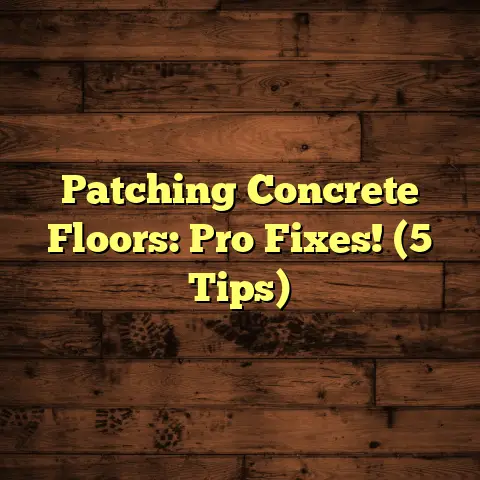Care For Engineered Wood? (2 Mistake Avoids!)
Engineered wood flooring is a fantastic choice for modern homes. It brings warmth and elegance. But, like any investment, it needs the right care to stay beautiful.
I’m here to guide you through the essential do’s and don’ts. I’ll highlight the biggest mistakes I see homeowners make. Trust me, avoiding these can save you a lot of heartache (and money!) down the road.
Section 1: Understanding Engineered Wood
So, what exactly is engineered wood?
It’s not solid hardwood. Instead, it’s made of layers. Think of it like plywood, but with a beautiful wood veneer on top. This construction gives it some serious advantages.
- Stability: Less likely to warp or expand/contract with humidity changes.
- Moisture Resistance: Better than solid hardwood, though not waterproof!
- Cost-Effective: Often more budget-friendly than solid wood.
You’ll find engineered wood in homes and businesses. It is a versatile option for living rooms, bedrooms, and even some kitchens.
Compared to solid hardwood, engineered wood is easier to install. It’s also a bit more environmentally friendly, using less of the precious hardwood resource. Plus, the design options are endless! You can find it in almost any wood species, color, and plank width you can imagine.
Section 2: The Importance of Care and Maintenance
Why bother with special care? I get it, life is busy!
But trust me, a little effort goes a long way. Proper care protects your investment in the long run.
- Longevity: With the right care, engineered wood can last for decades.
- Appearance: Regular maintenance keeps it looking its best, day after day.
- Investment Protection: Avoid costly repairs or replacements by being proactive.
I often hear misconceptions about engineered wood care. One of the biggest is that it’s indestructible. Not true! It’s durable, but not immune to damage. Another myth is that you can treat it just like solid hardwood. Again, not quite! The veneer layer is thinner, so you need to be more gentle.
Section 3: Mistake #1 – Using the Wrong Cleaning Products
This is a HUGE mistake I see all the time.
Using the wrong cleaning products can ruin your engineered wood floor. Some of the worst offenders include:
- Abrasive Cleaners: These scratch the surface and dull the finish.
- Oil-Based Products: They leave a sticky residue that attracts dirt.
- Excessive Water: Water can seep into the seams and damage the core.
So, what should you use? Look for pH-balanced cleaners specifically designed for engineered wood. These are gentle and won’t damage the finish. Always check the manufacturer’s recommendations for your specific flooring.
Here’s my step-by-step guide to cleaning engineered wood effectively:
- Gather Your Supplies: You’ll need a microfiber mop, a soft cloth, and your approved cleaner.
- Dry Clean First: Sweep or vacuum to remove loose dirt and debris. I recommend a vacuum with a soft brush attachment.
- Damp Mop: Lightly spray the floor with your cleaner (or apply it to the mop).
- Wipe Gently: Use the damp mop to clean the floor, working in sections. Avoid soaking the floor!
- Dry with a Cloth: If needed, dry any remaining moisture with a clean, soft cloth.
Pro Tip: Never pour water directly onto the floor!
Section 4: Mistake #2 – Neglecting Preventative Measures
Prevention is key! Think of it like this: it’s easier to prevent a scratch than to fix one.
Here are some common preventable issues I see:
- Lack of Floor Mats: Dirt and grime tracked in from outside can scratch the floor.
- No Furniture Pads: Furniture legs can dent or scratch the surface.
- Ignoring Humidity: Extreme humidity changes can damage the wood.
Here are some practical tips for maintaining an optimal environment:
- Use Floor Mats: Place mats at all entryways to trap dirt and moisture.
- Use Furniture Pads: Put felt pads under all furniture legs.
- Control Humidity: Aim for a humidity level between 30-50%. Use a humidifier or dehumidifier as needed.
- Trim Pet’s Nails: Keep your furry friends’ nails trimmed to minimize scratches.
- Avoid High Heels: High heels can dent the floor, especially in high-traffic areas.
According to the EPA, maintaining indoor humidity levels between 30-50% can also help prevent mold growth. (Source: EPA Indoor Air Quality)
Section 5: Daily and Seasonal Maintenance Routines
Consistency is key! A little bit of maintenance every day goes a long way.
Daily Maintenance:
- Dusting and Sweeping: Remove loose dirt and debris daily. This prevents buildup that can scratch the floor.
Seasonal Maintenance:
- Check for Gaps: Look for gaps between planks, especially during dry seasons.
- Adjust Humidity: Adjust your humidifier or dehumidifier as needed to maintain optimal humidity levels.
- Inspect for Wear: Check for any signs of wear and tear, such as scratches or dents.
When to Call a Pro:
- Deep Cleaning: Consider professional deep cleaning every 12-18 months.
- Repairs: If you have significant scratches, dents, or water damage, call a professional for repairs.
Pro Tip: I always recommend consulting with a flooring professional. We can assess the condition of your floor and recommend the best course of action.
Section 6: Real-Life Examples and Case Studies
I’ve seen firsthand how proper care makes a difference.
I had one client, Sarah, who diligently followed my care instructions. Years later, her engineered wood floor still looked brand new. She used the right cleaning products, had mats at every entrance, and kept the humidity in check.
On the other hand, I had another client, Mark, who neglected his floor. He used abrasive cleaners, never used furniture pads, and ignored humidity levels. Within a few years, his floor was scratched, dull, and had water damage. He ended up having to replace it!
(Insert before-and-after photos here, if available. Show a well-maintained floor versus a neglected floor.)
These examples show the real-world impact of proper care. It’s not just about aesthetics; it’s about protecting your investment and ensuring your floor lasts for years to come.
Conclusion
Engineered wood flooring is a beautiful and durable choice. But it needs the right care to stay that way.
Remember these two key mistakes to avoid:
- Using the Wrong Cleaning Products: Stick to pH-balanced cleaners designed for engineered wood.
- Neglecting Preventative Measures: Use mats, furniture pads, and control humidity.
By following these tips, you can ensure your engineered wood floor remains beautiful and functional for years to come. You’ll not only protect your investment but also enjoy the warmth and elegance of your floor every day.
Call to Action
What are your experiences with engineered wood care? Do you have any questions or tips to share? Let me know in the comments below! I’m always happy to help.





